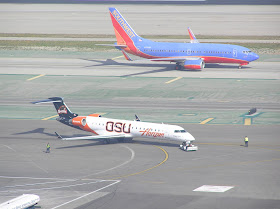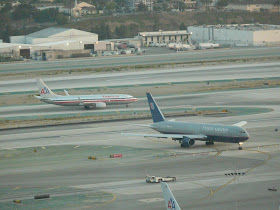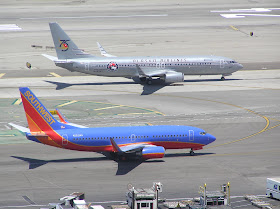
Continuing the B737 spotter's guide, we'll take a look this time at the current production models, collectively dubbed the Next Generations. This series has four models, the -600, -700, -800, and -900. Unlike the Classic series, the Next Generation series models make sense, as they range from the smallest (B737-600) to the largest (B737-900). The new models have taller tails, greater wingspans, and rounder engine cowlings than the Classics, although this can be hard to judge unless they're seen together.
B737-600 (B736)
The -600 is the smallest and the rarest of the current B737 models. It replaced the -500 in the Classic series, and is roughly comparable in size and passenger capacity. WestJet started bringing them into LAX this summer, and is (so far, anyway) the only operator to bring the B736 into LAX. Maximum seating capacity of the B736 is 132, although WestJet's are configured for 119 passengers. Unlike all the other Next Generation models, winglets have not yet been installed on the -600s, although there's no reason that they couldn't be. WestJet reportedly was considering being the launch customer for -600 winglets, but opted not to pursue it. The main advantage winglets offer to the airlines is increased fuel efficiency; that efficiency occurs primarily in the cruise portion of the flight, and therefore is best gained on the longer routes for which the B736's smaller capacity is not particularly well suited. The B736 competes with the Airbus A318 as well as the largest of the CRJ and ERJ models.
B737-700 (B737)

The -700 is one of the most common aircraft at LAX; Southwest has more -700s (343) in their fleet than other models combined, for instance. Alaska, AeroMexico, Continental, AirTran, and WestJet are other regular -700 users here. The -700 replaced the -300 in the Classic series, and is of similar size and capacity (maximum 149 passengers, although most LAX operators have their -700s configured for about a dozen less). The Airbus competitor is the A319 (156 passengers maximum), which is also frequently seen at LAX. The shortest B737-700 flights out of LAX are less than an hour, to Las Vegas and the Bay area (Oakland/San Francisco/San Jose); the longest, at over five hours, is Alaska's summer service to Anchorage (no one seems to want to go there in the winter . . . )

 A pair of Southwest -700s. Spotter's tip: Southwest paints the flap track fairings (the canoe-looking things) on the bottom of the wing orange on their -700s to alert ground crews to the -700's greater wingspan as compared to the -300s and -500s. This practice doesn't carry over to the themed paint schemes like Shamu; check the shot below; the blue aircraft is a -300:
A pair of Southwest -700s. Spotter's tip: Southwest paints the flap track fairings (the canoe-looking things) on the bottom of the wing orange on their -700s to alert ground crews to the -700's greater wingspan as compared to the -300s and -500s. This practice doesn't carry over to the themed paint schemes like Shamu; check the shot below; the blue aircraft is a -300:
 Another pair of -700s; Alaska and Southwest's commemorative Desert Gold livery (of which there are only three); This particular -700 is named for Southwest founder Herb Kelleher
Another pair of -700s; Alaska and Southwest's commemorative Desert Gold livery (of which there are only three); This particular -700 is named for Southwest founder Herb Kelleher A pair of AirTran B737s
A pair of AirTran B737s An AeroMexico B737 between an Avianca B762 and a Taca A320
An AeroMexico B737 between an Avianca B762 and a Taca A320


 B737-700s and rival Airbus model A319s
B737-700s and rival Airbus model A319s With a (now retired) Midwest (formerly Midwest Express) MD-80
With a (now retired) Midwest (formerly Midwest Express) MD-80 With a B717 (nee MD95 - the smaller version of the MD-90, the MD-80's replacement)
With a B717 (nee MD95 - the smaller version of the MD-90, the MD-80's replacement) Family portrait: Alaska B737 (left), B738 (top right), and B739 (lower right)
Family portrait: Alaska B737 (left), B738 (top right), and B739 (lower right)





 Southwest's original gold scheme, aka 'Corndog'
Southwest's original gold scheme, aka 'Corndog' With an E-120 Brasilia
With an E-120 Brasilia With a Skywest CRJ2
With a Skywest CRJ2 With a Horizon Dash-8
With a Horizon Dash-8 From the archives: With a Jetlink (flying as Delta Connection) E-145
From the archives: With a Jetlink (flying as Delta Connection) E-145 With a Horizon CRJ7
With a Horizon CRJ7 With a LAN B767-300
With a LAN B767-300 Illinois One with a landing MD-11
Illinois One with a landing MD-11 With a B747-400
With a B747-400 With a B777-300
With a B777-300 I think I used this as a trick question during the name-that-tail series
I think I used this as a trick question during the name-that-tail series
 B737-700s with -800s, the next larger model in the Next Generation series
B737-700s with -800s, the next larger model in the Next Generation series
I suppose that we see more -800s at LAX these days than any other model of the Boeing 737. While Southwest doesn't have them, nearly everyone else using B737s here does: Alaska, American, Continental, Copa, Delta, Sun Country, and WestJet; even AeroMexico brings them in periodically. Last-minute update: Southwest is reportedly considering adding B738's to their fleet to increase capacity at slot-limited airports Dallas News article. There are more destinations served from LAX by B738s than any other model of aircraft - I counted nearly fifty. The B738 is about ten feet longer (130 ft/39.5 m) than the B734 it replaced, and carries about a dozen more passengers (189 maximum capacity). Like the other versions, most LAX users have their -800's configured for fewer passengers than maximum; the average seems to be about 160. Its primary competitor is the 180-passenger (maximum) Airbus A320, also very commonly seen at LAX. The longest B738 flights out of LAX are about six hours: Continental flies them to Hawaii (Honolulu and Maui) and Copa flies them to Panama.











 Old and new: Alaska B734 (white) and B738 (75th Anniversary)
Old and new: Alaska B734 (white) and B738 (75th Anniversary)The B738 replaced the B734; ironically the new airplane has the retro livery
 Family portrait at the Delta terminal: A pair of B738s, one with winglets, one without; seen with a B752 (top) and B763 (the big plane in the middle)
Family portrait at the Delta terminal: A pair of B738s, one with winglets, one without; seen with a B752 (top) and B763 (the big plane in the middle)
 With B757-200s
With B757-200s With an Airborne (callsign: Abex) B767-200
With an Airborne (callsign: Abex) B767-200

 With B767-300s
With B767-300s With a Thai A340-500
With a Thai A340-500
 With B747-400s
With B747-400s
 B738s with B737s: the -800s are nearly 20 feet longer, and have two overwing exits to the -700's one
B738s with B737s: the -800s are nearly 20 feet longer, and have two overwing exits to the -700's one This pair of WestJets represents the largest and smallest of their fleet: A B736 (119 seats) and a B738 (166 seats). The B736 is reminiscent of the old B732; it makes the B738 look like a heavy
This pair of WestJets represents the largest and smallest of their fleet: A B736 (119 seats) and a B738 (166 seats). The B736 is reminiscent of the old B732; it makes the B738 look like a heavyB737-900 (B739)

The final and largest (so far, anyway) model in the Next Generation series is the -900. Nearly ten feet longer than the -800, the B739 has a maximum seating capacity of 215 . . . well, sort of; it depends. Let me explain: Unlike all the other B737 models, there is an easily discernible difference between the two main variants of the -900 (although they are coded the same [B739] on our flight plans and equipment). The original version, the B737-900, is flown by Alaska, and has the stretched fuselage. Maximum seating capacity remains the same as the -800 (189) because of emergency exit requirements; Alaska's -900s are configured for 172 passengers. Boeing has since replaced the -900 with the B737-900ER, which has an added pair of exit doors (one on each side) along the rear fuselage; notice the gap in the windows on the Continental -900s as compared to the Alaska -900s. The additional exits increased the maximum allowable seating to 215, although Continental uses 173. The additional allowable seating allows the -900ER to better compete with the Airbus A321, which has a maximum seating capacity of 220. The primary A321 user at LAX is US Air, whose A321s are configured for 183 passengers. Alaska and Continental are (so far) the only B739 operators at LAX, although that may change in the future, as Boeing is marketing the -900ER as a replacement for the discontinued B757-200s that many US carriers are currently using. The B752 has a maximum seating capacity of 234, although most LAX operators have theirs configured for around 180 passengers.




 Continental B738 (green winglets, foreground) and B739
Continental B738 (green winglets, foreground) and B739 Continental B739 with an Alaska B738
Continental B739 with an Alaska B738

 With the smaller B737-700
With the smaller B737-700 This shot shows the additional rear exit of the B737-900ER - which makes it easy to tell a Continental B738 from a Continental B739. I haven't yet found a quick and easy way to differentiate Alaska's B738s and B739s other than looking at the flight plan or radar data tag. The tedious way is to count the windows (the right side of an Alaska B738 has 14 windows in a group behind the front door, while an Alaska B739 has 18; the Alaska B738 has 12 windows behind the front door on the left side, while the left side of an Alaska B739 has two groups of 8). To assemble the photos for this piece, I had to resort to checking the aircraft registrations to ensure that I had them right. Spotter tip: Alaska's B739s have US registration numbers in the 300s: N317AS, N320AS, etc. Also, Alaska has the aircraft model marked on the nosegear doors; you may just be able to pick it out in some of the better-quality photos here.
This shot shows the additional rear exit of the B737-900ER - which makes it easy to tell a Continental B738 from a Continental B739. I haven't yet found a quick and easy way to differentiate Alaska's B738s and B739s other than looking at the flight plan or radar data tag. The tedious way is to count the windows (the right side of an Alaska B738 has 14 windows in a group behind the front door, while an Alaska B739 has 18; the Alaska B738 has 12 windows behind the front door on the left side, while the left side of an Alaska B739 has two groups of 8). To assemble the photos for this piece, I had to resort to checking the aircraft registrations to ensure that I had them right. Spotter tip: Alaska's B739s have US registration numbers in the 300s: N317AS, N320AS, etc. Also, Alaska has the aircraft model marked on the nosegear doors; you may just be able to pick it out in some of the better-quality photos here. With an American MD-80
With an American MD-80 With a B737-300
With a B737-300 With a Virgin America A320
With a Virgin America A320 With an arriving Shanghai Cargo MD-11
With an arriving Shanghai Cargo MD-11
 I couldn't find a single photo (!) of a B739 with the competing A321, so instead here's a pair of photos showing another aircraft, in this case a B777-200, with one of each
I couldn't find a single photo (!) of a B739 with the competing A321, so instead here's a pair of photos showing another aircraft, in this case a B777-200, with one of each With a B752, for which Boeing is marketing the B739 as a replacement
With a B752, for which Boeing is marketing the B739 as a replacementUgh - I didn't think I was ever going to get this segment done! I'm sick of looking at B737 photos; I'll bet I've looked at a thousand at least while putting this series together - and there's still one more part to come, albeit not nearly as long (I hope!)
Alaska Fleet
American Fleet
Continental Fleet
Delta Fleet
Southwest
US Airways
WestJet Fleet
Wikipedia A320 series
Wikipedia B737
Wikipedia B737 Classics
Wikipedia B737 Next Generation
Wikipedia B757
Airframes.org Aircraft Registration database






An amazing display of photos! I especially like the comparison pictures and the family portraits.
ReplyDeleteN